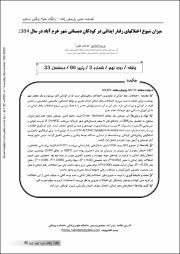Prevalence of Disruptive Behavior Disorders in Elementary-School Students of Khorramabad
(ندگان)پدیدآور
Namdari, parisaNazari, hedayatنوع مدرک
TextResearch
زبان مدرک
Englishچکیده
Namdari P1, Nazari H2 1. Instructor, Department of Social Medicine, Faculty of Medicine, Lorestan University of Medical Sciences 2. Assistant Professor, Department of Psychiatry, Faculty of Medicine, Lorestan University of Medical Sciences, Iran Abstract Background: Disruptive Behavior Disorder (DBD) is one of the most prevalent psychiatric disorders starting from childhood and is considered an important mental health problem of the society. DBDs may have distractive effects on the social, educational, personality, and behavioral relationships of people in their childhood and adulthood. The present research was done to determine the prevalence of Disruptive Behavior Disorders in elementary school students of Khorramabad in 2005. Materials and methods: This research was a cross-sectional study. Its statistical community includes all the students studying in grades one to five at elementary schools in Khorramabad (N = 943). Sixteen state and private schools (8 for girls and 8 for boys) were selected in a cluster and multi–stage sampling method. The standardized questionnaire of Child Symptoms Inventories (CSI-4) was used to collect data on the prevalence of children’s psychiatric disorders. The results ware analyzed using descriptive statistic and Chi-square test. Results: The total sample included 943 children. There was 21.4% DBD behavior (17.7% oppositional defiant disorder and, 3.7% conduct disorder). The number of the boys was twice as that of the girls (28.7% vs. 14.4%). The students in grade 2 showed the lowest, and those in grade 3, 4 and 5 the highest prevalence rate of DBD. There was also a significant relationship between children’s grade (P= 0.02), parent’s education (P=0.005, P=0.006), Mother’s job (P= 0.03), income (P = 0.005) and DBD. However no significant relationship between father’s job, educational level of the students and parent’s mental problems and Disruptive Behavior Disorders was found. Conclusion: Due to the high prevalence of the disorder including DBD, and lack of enough attention to their consequences in children and adolescents, it seems necessary to identify these disorders so that they may be dealt with on time.
کلید واژگان
Disruptive Behavior Disordersconduct disorder
oppositional defiant disorder
prevalence
children
شماره نشریه
3تاریخ نشر
2007-10-011386-07-09





